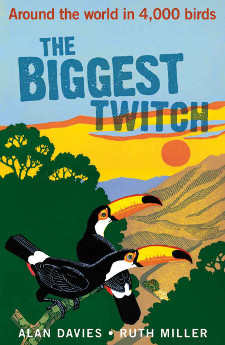Reviewed by Grant McCreary on August 6th, 2012.
I love reading “big year” books – accounts of people trying to see as many birds as possible in a single year. A birding big year can be done in many different ways and confined to any number of geographic boundaries. Indeed, I’ve reviewed books detailing big years in a single state (Chasing Birds Across Texas), the ABA area (Extreme Birder: One Woman’s Big Year), a continent (The Big Twitch), and even for a particular family of birds (The Jewel Hunter). But among all the big year books I’ve read, there has been a glaring omission. Where was a book about a big year spanning the entire world? Enter The Biggest Twitch.
In 2008, Alan Davies and Ruth Miller set out to see as many birds as possible, with the specific goal of breaking the existing record of 3,662 species, set by Jim Clements in 1989. In order to do so, they quit their jobs, sold their house, and spent all their money (plus some) on a crazy amount of travel. Over a dozen countries and thousands of birds later, they….well, I’m not going to spoil it for you. But what a year!
So what makes big year books so compelling to birders? For me, the main thing is the vicarious birding that it allows. Due to a variety of reasons, I can’t do any big year right now, much less a global one. But when I read about it, I’m transported. Alan and Ruth’s thrill at encountering a Resplendent Quetzal or Harpy Eagle is palpable, and I feel it too. I hope, one day, to go to many of the places our intrepid couple visited in the course of The Biggest Twitch, so this feels like a teaser for what’s to come. And if I don’t get to Kruger National Park, Manu, or one of the other fabulous locations in this book, reading about them is better than nothing.
Except for the jealousy. Yes, there is a dark side to big year books, especially The Biggest Twitch. They can make you insanely jealous. On day 19, the biggest twitchers had seen almost exactly the same number of birds as I have after 8+ years of birding. Sigh. Then there’s this seemingly innocuous sentence: “Our birding month in Australia had started peacefully enough.” Birding month? In Australia? Ok, I know they were going all out for an entire year, but when phrased like that it’s like a punch in the gut to one who’s thrilled with the occasional birding weekend.
Now that I’ve got that out of my system, I can get back to what makes big year books so great. If you bird hard for a year, it’s a given that you’ll see plenty of great birds and fantastic places. But you’re also bound to experience what in the book industry is, perhaps euphemistically, called “travel adventure”. Alan and Ruth certainly experienced their share, which makes for an entertaining read. Just a few examples:
- Almost getting burned to a crisp in a wildfire
- A forest floor alive with leeches
- Passport issues
- Run-ins with local authorities who were, uh, less than upright
- Finding themselves in a sinking boat
Big year books aren’t just entertaining; you can also learn much about the birds seen and places visited. Of course, the authors can’t describe every single bird or detail their natural history. But sometimes they tend to be a little too terse for my taste. They mention, for instance, that they didn’t realize how lucky they had been to see a Noisy Scrub-bird in Australia until some local birders had informed them later on. But there is no mention as to why it was such luck. (Apparently, this rare bird is easy to hear but a bugger to see, and was even “lost” for a while and presumed extinct.) Still, you can learn a good bit. If nothing else, you’ll likely get exposed to birds and places you’ve never even heard of before. And you can pick up on other random tips, such as when traveling through Africa you should always fill up on fuel whenever possible and get local currency ahead of time. Don’t forget, or you might also be forced to barter your cell phone for gas.
Finally, perhaps the most surprising thing that makes big year books a favorite of mine is that they are almost universally well-written. It seems like it would be hard to avoid falling into the pattern of repeating “I went here and saw such-and-such”. But, for the most part, The Biggest Twitch avoids this trap. One of the ways that Davies and Miller accomplish this is by splitting authorial duties. Basically, one of them would write a chapter, and then the other would tackle the next. Their styles are similar enough not to be jarring, but sufficiently different to add a little variety. It was a good idea on their part. Overall, I found this book to be amusing with very few dull stretches.
The Biggest Twitch includes a few pages of color photographs from the authors’ travels, which is a nice inclusion. However, the lack of an index and list of birds seen is unfortunate.
Recommendation
If you’ve ever wondered what it would be like to drop everything and go birding all over the world, then you should read The Biggest Twitch. That is, if you think you can resist the powerful encouragement to actually do so!
Disclosure: I get a small commission for purchases made through links in this post.





Comment